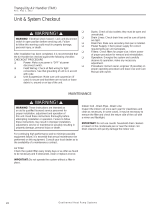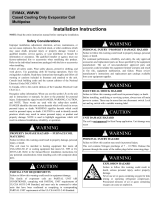
5
Condensate Drain
CAUTION:
The coil must be level to ensure proper
condensate drainage. Improper condensate
disposal may result in structural damage,
premature equipment failure, or possible
personal injury.
• Methodsfordisposingofcondensatevaryaccording
tolocalcodes.Refertolocalcodesorauthorityhaving
jurisidiction for restrictions and proper condensate
disposal requirements.
• Allcondensatepanshaveprimaryandsecondarydrain
connectionstomeetFHArequirements.Iftheapplication
is located in or above a living space where damage
mayresultfromcondensateoverow,aseparate3/4
inch drain must be provided from the secondary drain
connection and a secondary drain pan must be installed
undertheentireunit.Runsecondarydrainlinestoa
place where they are noticeable if used.
• Thecoilcondensatepanisdesignedwith3/4”NPSC
drainconnections.UseaPVCorsimilarmaterialtting
to attach the drain line to the pan. NOTE:Thetting
should be hand tightened only. Overtightening may
crack the drain pan and cause condensate to leak.
• The drain pan MUST be drained with eld supplied
tubing and looped to form a trap.
IMPORTANT: Failure to install a trap may result in
condensation overflowing the drain pan, resulting in
substantial water damage to surrounding area.
WARNING:
ELECTRICAL SHOCK, FIRE OR EXPLOSION
HAZARD
Failure to follow safety warnings exactly could
result in serious injury or property damage.
Improper servicing could result in dangerous
operation, serious injury, death or property
damage.
power to the furnace or air handler.
to disconnecting. Reconnect wires correctly.
CAUTION:
Do not operate the system without a suitable
filter in the return air duct system. Always
replace the filter with the same size and type.
Toensureoptimumperformanceandtominimizepossible
equipment failure, the following maintenance tasks should
be performed periodically on this equipment:
1.Theairlterinstalledwiththesystemshouldbechecked
and cleaned or replaced twice per year.
2. Check the coil, drain pan, and condensate drain line
for cleanliness at the start of each heating and cooling
season. Clean as needed.
• Primethetrapwithwater.Insulatethedrainifitislocated
in an unconditioned space, and test the condensate line
for leaks. Consult local codes for additional restrictions
or precautions.
• Routethelinestoasuitabledrain,avoidingsharpbends
andpinchingofthelines.Thedrainshouldmaintaina
minimum horizontal slope in the direction of discharge
ofnolessthan1”verticalforevery10ftofhorizontal
run.
• During system checkout, inspect the drain line and
connections to verify proper condensate drainage.
Air Filter
Air filters are not supplied as an integral part of this
coil; however,an air lter kit isavailable. Refer to the
ReplacementPartsListforavailablepartnumbers.
The lter must be installed upstream of the coil and
inspected frequently. When the filter becomes clogged
with dust or lint, it should be replaced (disposable type)
or cleaned (washable type). It is recommended that filters
be inspected and replaced at least twice during the year.
Generally it is best to replace or clean the filters at the
start of each heating and cooling season.
IMPORTANT: To prevent internal oxidation and
scaling from occuring, braze all connections with
dry nitrogen flowing through the joints.
4. Wrap the refrigerant lines with pressure sensitive
neoprene or other suitable material especially
where the lines enter the opening in the sheet metal.
NOTE:OnhorizontalmodelswithaTXVvalve,reposition
thesensingbulbtothe4or8o’clockpositiononthe
suction line.
Completing the Installation
1.Checkthesystemforleaks,includingthelinesetandthe
brazed joints. NOTE: Apply a soap and water solution on
each joint or union with a small paintbrush. If bubbling
is observed, the connection is not adequately sealed.
2. Evacuate the system of moisture and non-condensables
to prevent low efficiency operation or damage to the
unit.Thesuggestedrangeofevacuationis250-500
microns.
3. Charge the system with refrigerant. Please Refer to
the outdoor unit installation manual for additional
charging instructions.
4. Install the coil access door (if removed).
5.Properlydisposeofallremovedparts.
6.Applypowertotheunit.









